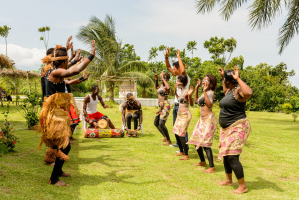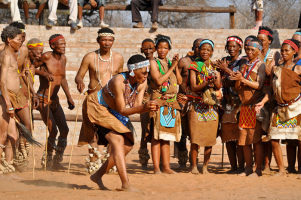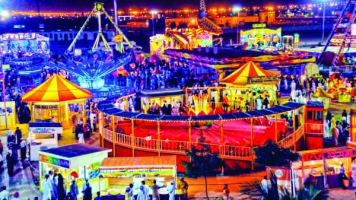Top 13 Most Famous Festivals In Spain
Spain is recognized for its spectacular festivals that take place throughout the year, bringing together thousands of locals to commemorate special occasions. ... read more...Spain is a fascinating country with numerous subtle subtleties. The culture of the country has been shaped by the country's vast history, which spans thousands of years. Fiestas are the Spanish word for festivals, and many of these events are eagerly awaited by people throughout the year. Here Toplist brings to you the most famous festivals in Spain.
-
La Tomatina festival is notorious for being both extremely enjoyable and filthy. This event takes place in the small village of Buol, which is roughly 40 kilometers west of Valencia, Spain's most beautiful city. It is estimated that up to 10,000 people attend each year! The festival is widely known and undoubtedly one of the most famous festivals in Spain.
The festival begins in the early hours of the morning, around 9 a.m. People scramble to get to a giant slab of ham hoisted up on a tall pole in the town square. Because the pole is constantly highly lubricated, it's quite rare for somebody to really reach the ham. After 2 hours of unsuccessful attempts to approach the ham, trucks started to dump tons of ripe tomatoes to the public about 11 a.m. At this point, a cannon fires to signify the commencement of the chaos and mayhem. For an hour, everyone will toss tomatoes at each other, resulting in a purée that will cover the entire area. At 12 p.m., a second cannon blasts, signaling the conclusion of the festivities, and the revelers joyously return home to clean up.
La Tomatina isn't for the faint of heart – or vegans, for that matter – but it'll be a one-of-a-kind celebration to remember.When: 26th August
Where: Buñol, Valencia Province
Photo: luhanhvietnam 
Photo: kienthuc.net -
As history demands, this colorful celebration takes place in the first or second week of May. The main draw is a spectacular display of some of the region's best horses. Feria Del Caballo takes place in Jerez, which is located in the beautiful Andalusia region.
Thousands of spectators from neighboring cities flock to this one-of-a-kind horse fair, which is also recognized for its other attractions, including as live flamenco dances and traditional food vendors. Many attendees complimented the festival as a fun event to observe and participate in. Make a plan to participate Feria Del Caballo if you're in Andalusia at this time.
When: 9th – 16th May
Where: Jerez de la Frontera, Andalusia
Photo: huelvainformacion 
Photo: wikipedia -
The San Fermin festival is a week-long, historically entrenched event celebrated every year in Pamplona, Navarre, in northern Spain. The festivities begin at 12 p.m on July 6 and go until midnight on July 14. The festivities begin with a firework display, and the popular song Pobre de m is sung at the conclusion. The most famous event is the running of the bulls, which takes place from July 7 to 14 at 8 a.m., although the festival also includes a variety of other traditional and folkloric activities. San Fermin is the local name for the festival, which is held in honor of Saint Fermin, Navarre's co-patron.
The annual San Fermin, perhaps one of the most famous festivals in Spain, is a perilous spectacle in which adrenaline-fueled locals of Pamplona seek to outrun raging bulls through the city's streets. This festival is extremely risky, and there have been numerous occasions where people have been seriously injured while participating in the race. This spectacular begins at 8 a.m. each day during the festival week and continues throughout the day. It is important to stress that we do not support bullfighting or animal cruelty.
When: 6th – 14th July
Where: Pamplona, Navarre Province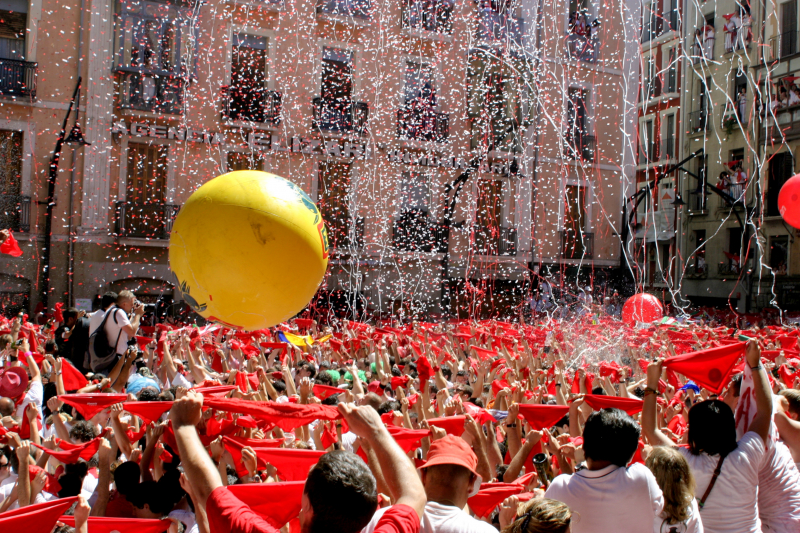
Photo: simple.wikipedia 
Photo: spain.info -
Semana Santa is one of Spain's most well-known traditional celebrations. This is owing to the fact that Roman Catholicism is the country's most popular religion. It's a pretty stunning event that takes place right before Easter week. During Holy Week, each city has its own distinctive celebrations. Semana Santa in some cities might be extremely somber, while in others they can be highly vibrant and joyous.
Most cities, on the other hand, will have large floats of religious icons such as Jesus and the Virgin Mary parading throughout the city. Musical groups playing drums and other instruments flank these. Regardless of your personal religious affiliation, just seeing everyone come together and spend time giving thanks for what they have is a truly humbling experience.
When: 5th – 12th April
Where: Most cities throughout Spain
Photo: latimes 
Photo: gialaipc -
This traditional feast honors Saint Joseph and takes place in the city of Valencia. Fallas is a Spanish word that refers to both the event and the huge monuments that are burned during the festivities. This annual event takes place in the month of March each year.
Each city neighborhood has an organized group of people known as the Casal Faller, who labor all year long to throw fundraising parties and dinners, usually featuring the well-known dish paella, a regional delicacy. Each casal faller creates a falla, which is finally burned. A casal faller is also known as a comissió fallera, and there are about 400 of them registered in Valencia right now.
The burning portion of this particular event is founded in old Pagan practices, which is an interesting fact. Las Fallas De Valencia is famous for its spectacular fireworks displays and live music. It's a fantastic opportunity to learn about local culture while also having a blast.
When: 15th – 20th March
Where: Valencia, Valencia Province
Photo: istockphoto 
Photo: recordrentacar -
This summer Festa Major De Gracia takes place in Barcelona, Spain's capital city, primarily in the Gracia area. On this day, almost the entire neighborhood comes together to celebrate the festivities and compete for the title of most beautiful and distinctively decorated street! Many consider the Gracia Event to be Barcelona's prettiest, most festive, and most hospitable street festival.
The Gracia festival lasts five days and features many great Catalan traditions, as well as a full schedule of performances and activities that bring the streets of Gracia to life. The festival takes place in Barcelona's Gracia neighborhood, which is 20 minutes on foot from the city's central plaza, Plaça de Catalunya, in the direction of the city's hill range to the north-west.
Festa Major De Gracia is not unusual for each of the district's streets to take the competition seriously and put up very spectacular displays. The decorations in the district are all different and colorful, making for a dreamlike experience. During this period, many street sellers and performers set up shop on the streets, adding to the bustling ambiance of the Gracia district.
When: 15th – 21st August
Where: Barcelona, Catalonia region
Photo: flickr 
Photo: theculturetrip -
The Haro Wine Festival, like La Tomatina, is dirty and raucous, and is notorious for its beer and wine fights. This festival takes place every year on June 29th, Saint Peter's Day. This raucous show can be traced back to the first Batalla Del Vino in the Middle Ages. This event, which is held in Rioja, is known to virtually quadruple the town's population by attracting foreigners and other Spaniards. The celebration is a lot of fun, and both Spaniards and foreigners enjoy it.
Participants must trek 7 kilometers to the hermitage of San Felices, following a person on horseback who portrays Haro, the mayor of the town. Following the completion of the walk, a short mass is held before total mayhem ensues, with people dousing each other in wine from buckets, bottles, and water pistols.
When: 28th – 30th June
Where: Haro, La Rioja province
Photo: itinari 
Photo: escape -
La Tamborrada takes place in the rugged Basque area of Donostia-San Sebastian. The entire city gets together to celebrate the traditions and culture of their community.
La Tamborrada begins on the 19th of January at 12 a.m. and ends at 12 a.m. the following day. Everyone gathers in the Plaza de la Constitución to watch the raising of the city flag, and everyone sings the city anthem together. Following that, parades and drumming troupes take place.
The drumming continues for the entire duration of the festival. Drummers are known for dressing up in authentic army attire. Everyone meets in the square at midnight the following day to sing the city's song one last time before witnessing the flag being lowered.When: 20th January
Where: San Sebastián, Basque Country
Photo: sansebastianturismoa 
Photo: pinterest -
The Seville Fair (officially and in Spanish: Feria de Abril de Sevilla, "Seville April Fair") takes place in Seville, Spain, the Andalusian capital. The fair usually starts two weeks following the Easter Holy Week, or Semana Santa. The fair begins at midnight on Saturday and goes for seven days, ending on Saturday the following week. The celebration begins each day at lunchtime with a parade of carriages and horsemen conveying Seville's leading inhabitants to the bullring, La Real Maestranza, where bullfighters and breeders congregate.
The fairgrounds and a large area on the far bank of the Guadalquivir River are completely covered in rows of casetas throughout the duration of the fair (individual decorated marquee tents which are temporarily built on the fairground). These casetas are frequently associated with famous Seville families, friendship groups, clubs, trade associations, and political parties. There are crowds celebrating and dancing sevillanas, drinking Sherry, manzanilla, or rebujito, and eating tapas from around nine o'clock at night until six or seven o'clock the next morning, initially in the streets and then solely within each caseta. This fair also has an entertainment park with a variety of games to play as well as roller coasters to ride. The Feria de Abril is attended by a lot of people and is undoubtedly one of the most famous festivals in Spain.
When: 26th April – 2nd May
Where: Seville, Andalusia
Photo: visitasevilla 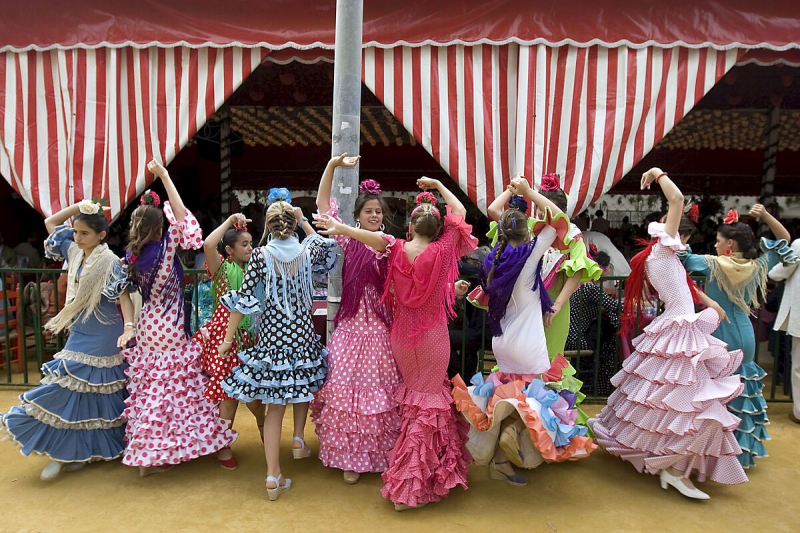
Photo: elmundo -
The Patios Cordobeses Festival is a patio tournament conducted in Córdoba, Spain, every second and third week in May. The participants decorate and open their patios for free to the public during the hours set aside for that purpose. Patios in contests have been designated with potted bushes flanking the doors in recent years so that they may be easily recognized.
Recently created courtyards are admitted to the competition, establishing two categories: historical architecture and new architecture, in order to stimulate the festival and preserve the city's unique architecture. The competition has attracted up to 50 patios in recent years. In addition, the festival concludes with a Córdoba City Council-sponsored educational program aimed at raising student awareness of architecture and heritage while also encouraging respect for it.
The Patios Cordobeses Festivalis rounded off with a verbena in the San Basilio area, where the neighborhood residents' organization puts up a bar next to the Belén tower and the bars on San Basilio street contribute with music and drink sales to the groups of Cordovans and tourists who gather there.
They were designated as a Festival of National Tourist Interest in 1980, and on December 6, 2012, UNESCO recognized them as Intangible Cultural Heritage of Humanity after a lengthy procedure.When: 4th – 17th May
Where: Cordoba, Andalusia
Photo: migratingmiss 
Photo: ruralidays -
Feria De Málaga is a festival annual in Magala , which takes place in August, is a week-long street extravaganza featuring plenty of flamenco and 'fino' (sherry). The fair, which commemorates Isabella and Ferdinand's re-conquest of the city in 1487, runs for a week from Saturday to Sunday during the third week of August.
Feria De Málaga- clicking party begins with a bang, literally, with a spectacular firework show in the Paseo del Parque that can be seen for miles. The greatest views are from the Port area, Muelle Uno, or hotel rooftop patio bars in the city center. On the Friday night before the opening Saturday, there will be a firewood show at midnight. This is usually followed by a free concert by a top Spanish artist or band on the beach at La Malagueta.It should be noted that getting through the city by car during this time can be fairly difficult due to the massive amount of traffic that is experienced on that day. Many party goers converge on this summer fair from around the country.
When: 15th – 24th August
Where: Malaga, Costa del Sol
Photo: vivi-homes 
Photo: golfelchaparral\ -
The Festival International de Benicàssim, generally abbreviated as FIB, is an annual music festival held in the Valencian Community's town of Benicàssim (Spain). The Benicassim Festival is widely considered to be Spain's largest music festival. It primarily features pop, rock, and electronica musicians, but it also includes short films, fashion presentations, and art. On the international festival circuit, Benicassim is regarded as one of the best.
Benicassim Festival formally starts on the second Tuesday of July when the camping grounds open, although the music doesn't start until Thursday afternoon. FIB is known for having bands play all night (5 p.m. – 8 a.m.) and for having three main stages, Las Palmas, Visa, and South Beach Dance, each with a capacity of 30,000, 15,000, and 8,000 people. The festival's capacity surpassed 50,000 in 2009, and over 150,000 people attended the four-day event in 20.
When: 16-19 July
Where: Castellón Province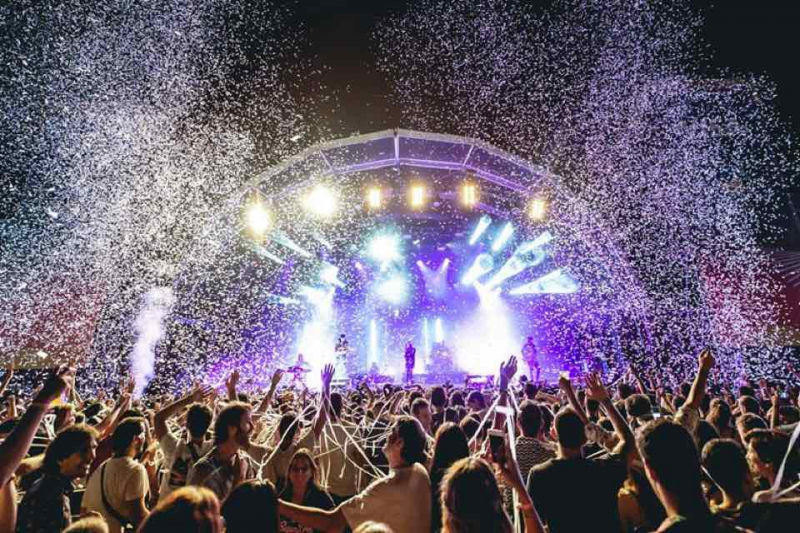
Photo: europebookings 
Photo: abahanavillas -
The Barcelona Beach Festival is an annual electronic music festival hosted in the Platja del Frum neighborhood of Barcelona. It is organized by Live Nation, and over 70,000 people are expected to attend each year. It is one of Spain's largest music festivals. David Guetta, Armin van Buuren, DJ Snake, and Dimitri Vegas & Like Mike are among the most recent performers. Every year, in the month of July, it takes place.
When: July
Where: Barcelona, Catalonia
Photo: festicket 
Photo: electricsoul




















